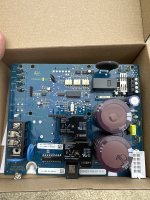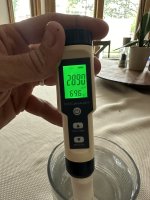- Apr 14, 2024
- 4
- Pool Size
- 22000
- Surface
- Plaster
- Chlorine
- Salt Water Generator
- SWG Type
- Hayward Aqua Rite (T-15)
Good Morning,
I'm new here and I'm needing some help. Last summer, my salt cell started giving me issues. The furnace had stayed on while the pump was off and I think it burned out the cell. I didn't realize this immediately, but The panel started showing that the pool was super low on salt. I added salt to the pool, but then found my cell to look like it was burned up. I tried acid washing it, but long story short, I replaced the T-15 cell with an aftermarket T-15. I took water samples to the local pool store for salinity tests, and got the levels in the pool back to where they should have been. However, the cell is still showing the levels 2000 ppm higher than what they actually were. I thought that maybe the thermistor was bad on the board, so I replaced the board in the panel, tried recalibrating and resetting the panel following the directions I've found online for the panel, but no matter what I do, the panel won't show any lower than 5300-5500 ppm on the display. This morning I backwashed the sand filter and rinsed it hoping that it would help. I then tried recalibrating and resetting the salt level on the panel again, but no matter what I do the levels are consistently too high. I had the water tested at the pool company yesterday and the levels in the pool are 2800 ppm in my pool. What am I doing wrong? Am I missing something? Please Help
I'm new here and I'm needing some help. Last summer, my salt cell started giving me issues. The furnace had stayed on while the pump was off and I think it burned out the cell. I didn't realize this immediately, but The panel started showing that the pool was super low on salt. I added salt to the pool, but then found my cell to look like it was burned up. I tried acid washing it, but long story short, I replaced the T-15 cell with an aftermarket T-15. I took water samples to the local pool store for salinity tests, and got the levels in the pool back to where they should have been. However, the cell is still showing the levels 2000 ppm higher than what they actually were. I thought that maybe the thermistor was bad on the board, so I replaced the board in the panel, tried recalibrating and resetting the panel following the directions I've found online for the panel, but no matter what I do, the panel won't show any lower than 5300-5500 ppm on the display. This morning I backwashed the sand filter and rinsed it hoping that it would help. I then tried recalibrating and resetting the salt level on the panel again, but no matter what I do the levels are consistently too high. I had the water tested at the pool company yesterday and the levels in the pool are 2800 ppm in my pool. What am I doing wrong? Am I missing something? Please Help





